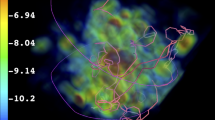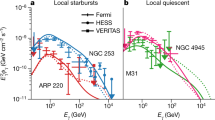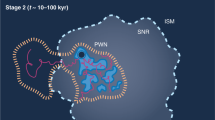Abstract
EVIDENCE on whether the majority of detected cosmic rays originate in our Galaxy has been inconclusive: arguments based on the abundance of uranium nuclei, the power available in supernovae, γ-ray emission, the absence of a 1020 eV cutoff, and the galactic origin of the electron component all involve uncertainties; but in each case a galactic origin seems to offer a more probable interpretation than an extragalactic origin. Near isotropy has until now been the discordant feature. Work by Krasilnikov et al.1 and Bell et al.2 now suggests that the arrival directions of the most energetic cosmic rays are almost certainly highly anisotropic. Although the distribution of arrival directions is quite different from that predicted by Karakula et al.3 for particles from galactic sources, we point out here that the evidence now indicates strongly a galactic origin for even the most energetic cosmic rays that reach us; we also suggest that there is a very extensive ordered magnetic field outside the plane of our Galaxy.
This is a preview of subscription content, access via your institution
Access options
Subscribe to this journal
Receive 51 print issues and online access
$199.00 per year
only $3.90 per issue
Buy this article
- Purchase on Springer Link
- Instant access to full article PDF
Prices may be subject to local taxes which are calculated during checkout
Similar content being viewed by others
References
Krasilnikov, D. D., et al., J. Phys., A, 7, L176–180 (1974).
Bell, C. J., et al. Proceedings of the 13th international Conference on Cosmic Rays, 4, 2525–8 (1973).
Karakula, S., Osborne, J. L., Roberts, E., and Tkaczyk, W., J. Phys., A, 5, 904–15 (1972).
Linsley, J., and Watson, A. A., Nature, 249, 816–7 (1974).
Kraus, J. D., and Ko, H. C., Nature, 172, 538–9 (1953).
Hillas, A. M., Phil. Trans. R. Soc. A 277, 413–428 (1974).
Linsley, J., Proceedings of the eighth international Conference on Cosmic Rays, 4, 77–99 (1963).
Sakakibara, S., J. Geomagn. Geoelect. (Kyoto), 17, 99–112 (1965).
Syrovatskii, S. I., Comments Astrophys. Space Phys., 3, 155–62 (1971).
Humble, J. E., et al. Proceedings of the 13th international Conference on Cosmic Rays, 3, 976–81 (1973); Daudin, J., Auger, P., Cachon, A., and Daudin, A., Nuovo Cim., 3, 1017–32 (1956); Cachon, A., Proceedings of the fifth Inter-American Seminar on Cosmic Rays, 2, XXXIX–1 (1962); Kota, J., NATO Advanced Study Institute on Cosmic Rays (in the press).
Brownlee, R., thesis, Univ. Sydney (1970).
Shklovskii, I. S., Soviet Astron., AJ, 17, 828–299 (1974).
Author information
Authors and Affiliations
Rights and permissions
About this article
Cite this article
HILLAS, A., OULDRIDGE, M. Cosmic rays and the Galaxy. Nature 253, 609–610 (1975). https://doi.org/10.1038/253609a0
Received:
Published:
Issue Date:
DOI: https://doi.org/10.1038/253609a0
This article is cited by
-
A diffusion model for cosmic ray propagation in the Galaxy
Astrophysics and Space Science (1980)
-
Origin of ultra high energy cosmic rays
Nature (1975)
Comments
By submitting a comment you agree to abide by our Terms and Community Guidelines. If you find something abusive or that does not comply with our terms or guidelines please flag it as inappropriate.



